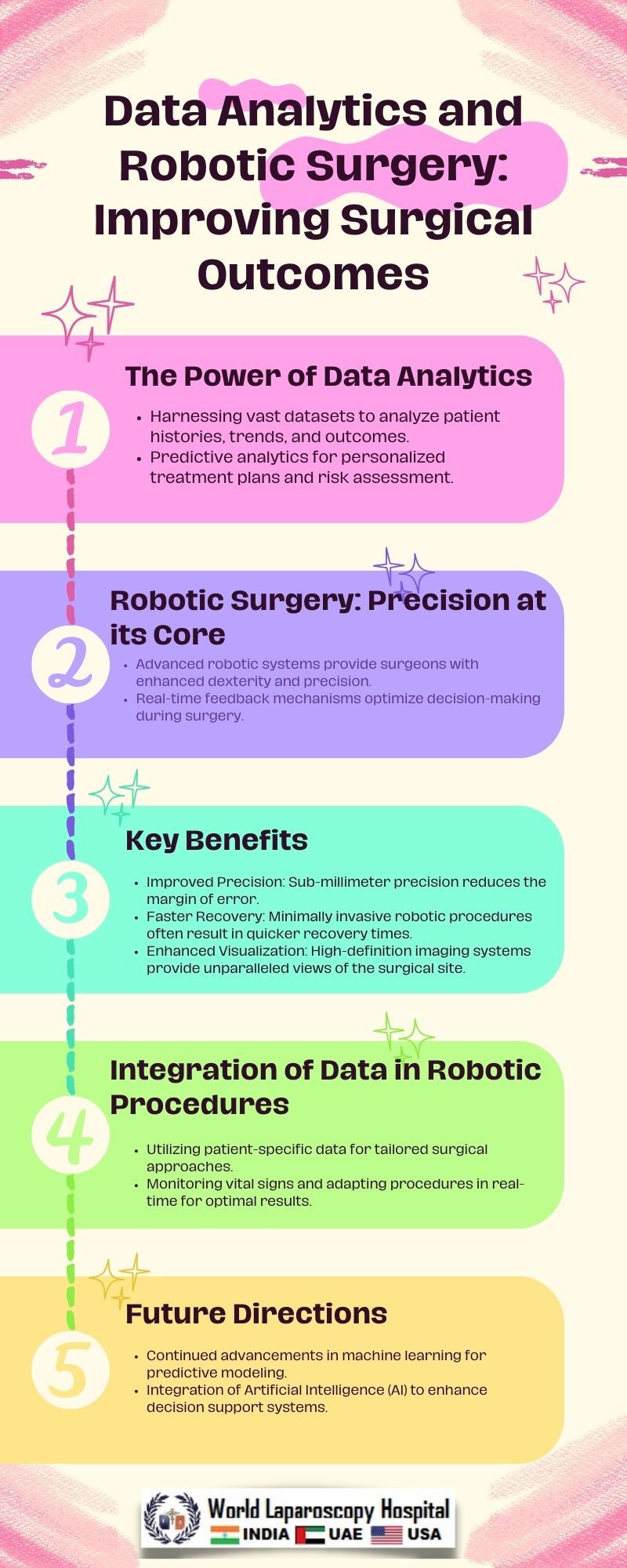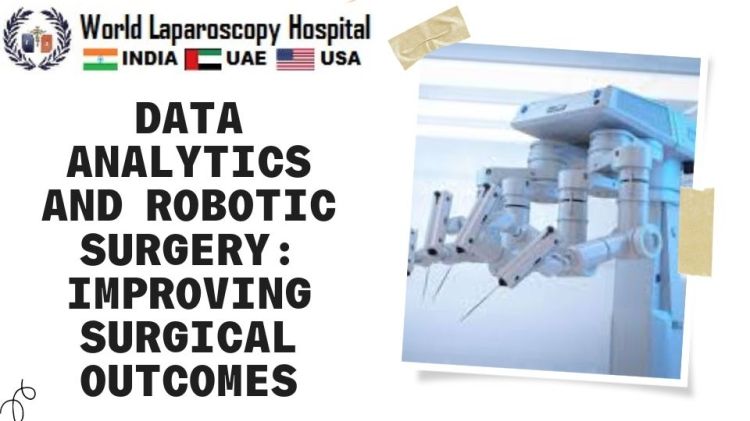Data Analytics and Robotic Surgery: Improving Surgical Outcomes
Introduction:
In the ever-evolving landscape of healthcare, the intersection of data analytics and robotic surgery has emerged as a groundbreaking paradigm, redefining the possibilities of surgical precision and patient outcomes. The amalgamation of advanced data analysis techniques with cutting-edge robotic technologies has opened new frontiers in the realm of surgery, offering surgeons unprecedented insights, real-time information, and enhanced decision-making capabilities.

Understanding Robotic Surgery:
Before delving into the transformative impact of data analytics, it's essential to grasp the fundamentals of robotic surgery. Robotic-assisted surgery involves the use of robotic systems to aid and augment the capabilities of surgeons during procedures. These systems typically consist of robotic arms equipped with surgical instruments, controlled by a console where the surgeon sits and manipulates the tools with hand and foot controls.
The primary goal of robotic surgery is to enhance precision, flexibility, and control, allowing surgeons to perform complex procedures with greater accuracy and reduced invasiveness. This minimally invasive approach often results in shorter recovery times, decreased postoperative pain, and improved cosmetic outcomes for patients.
The Role of Data Analytics:
Data analytics, on the other hand, involves the examination and interpretation of vast amounts of data to uncover meaningful patterns, trends, and insights. When integrated into the field of robotic surgery, data analytics serves as a catalyst for refining surgical techniques, optimizing patient outcomes, and advancing the overall quality of healthcare delivery.
Real-time Insights:
One of the key contributions of data analytics to robotic surgery is the provision of real-time insights. During surgical procedures, data analytics algorithms continuously analyze a wealth of information, including patient vitals, surgical instrument movements, and feedback from the robotic system. This real-time analysis enables surgeons to make informed decisions on the spot, adjusting their approach based on dynamic factors.
For example, if the algorithm detects subtle irregularities in a patient's vital signs or identifies potential complications, it can alert the surgeon immediately. This proactive response mechanism allows for timely interventions, potentially averting complications and ensuring a smoother surgical process.
Optimizing Decision-Making:
Data analytics equips surgeons with a comprehensive understanding of each patient's unique physiology and medical history. By leveraging predictive analytics, surgeons can anticipate potential challenges specific to an individual's health profile, enabling them to tailor their approach accordingly. This personalized and data-driven decision-making process contributes to improved surgical planning and execution.
Furthermore, data analytics plays a pivotal role in the postoperative phase by analyzing patient outcomes and identifying patterns that may inform future surgical strategies. This continuous feedback loop fosters a culture of continuous improvement, enhancing the overall quality of care provided.
Customizing Surgical Procedures:
The ability to customize surgical procedures based on individual patient data represents a paradigm shift in the field of medicine. Data analytics empowers surgeons to adopt a precision medicine approach, tailoring interventions to match the unique characteristics of each patient.
For instance, by analyzing genetic information, surgeons can identify specific factors that may influence a patient's response to certain medications or anesthesia. This insight allows for the customization of treatment plans, minimizing the risk of adverse reactions and optimizing the overall safety and efficacy of the surgical process.
Enhancing Surgical Training and Skill Development:
Data analytics also contributes to the training and skill development of surgeons engaged in robotic procedures. By collecting and analyzing data from various surgeries, educational institutions and healthcare facilities can create comprehensive training programs that simulate real-world scenarios.
Simulated training environments, enhanced by data-driven insights, enable aspiring robotic surgeons to refine their skills, practice challenging scenarios, and gain valuable experience in a controlled setting. This not only accelerates the learning curve for new surgeons but also ensures a standardized level of proficiency across the medical community.
Challenges and Considerations:
Despite the promising advancements facilitated by the integration of data analytics and robotic surgery, several challenges and considerations merit attention.
Data Security and Privacy:
The vast amounts of patient data involved in data analytics pose significant challenges regarding security and privacy. Healthcare providers must implement robust measures to safeguard sensitive information, ensuring compliance with data protection regulations.
Algorithm Accuracy and Validation:
The effectiveness of data analytics relies heavily on the accuracy of algorithms. Rigorous validation processes and continuous refinement are essential to ensure that algorithms provide reliable insights and contribute positively to surgical outcomes.
Cost Implications:
The implementation of robotic surgery systems and data analytics infrastructure involves substantial upfront costs. Healthcare institutions must weigh the long-term benefits against these initial investments and consider the potential impact on patient care and financial sustainability.
Training and Adoption:
The successful integration of data analytics and robotic surgery requires a well-trained and adaptable medical workforce. Ensuring that healthcare professionals receive comprehensive training on these technologies is crucial for widespread adoption and successful implementation.
Future Directions and Innovations:
Looking ahead, the synergy between data analytics and robotic surgery holds tremendous potential for further innovation and improvement in healthcare. Several avenues for future development include:
Artificial Intelligence (AI) Integration:
The incorporation of artificial intelligence algorithms into robotic surgery systems can elevate the level of automation and decision-making capabilities. AI-driven systems have the potential to adapt in real-time, learning from each surgical procedure to enhance future performance.
Remote Surgery and Telemedicine:
The combination of robotic surgery and data analytics opens the door to remote surgery and telemedicine. Surgeons could potentially perform procedures from a different location, leveraging data analytics to ensure optimal communication, control, and decision-making during remote surgeries.
Patient-Reported Outcomes and Experience:
Data analytics can extend beyond clinical parameters to include patient-reported outcomes and experiences. By integrating patient feedback into the analytics process, healthcare providers can gain valuable insights into the holistic impact of surgical interventions on patients' lives.
Global Collaboration and Knowledge Sharing:
Establishing platforms for global collaboration and knowledge sharing in the field of robotic surgery and data analytics can accelerate progress. Cross-disciplinary collaboration among researchers, clinicians, and technologists can foster the development of standardized practices and guidelines.
Conclusion:
The marriage of data analytics and robotic surgery represents a transformative force in the landscape of modern healthcare. By harnessing the power of real-time insights, personalized interventions, and continuous improvement, this synergistic approach holds the promise of revolutionizing surgical outcomes and patient care.
As we navigate the complexities of implementing these technologies, addressing challenges, and embracing ongoing innovations, the journey towards a future where surgical precision is augmented by data-driven insights is indeed an exciting and promising endeavor. The union of data analytics and robotic surgery has the potential to redefine the boundaries of what is possible in the operating room, paving the way for a new era of healthcare excellence.
